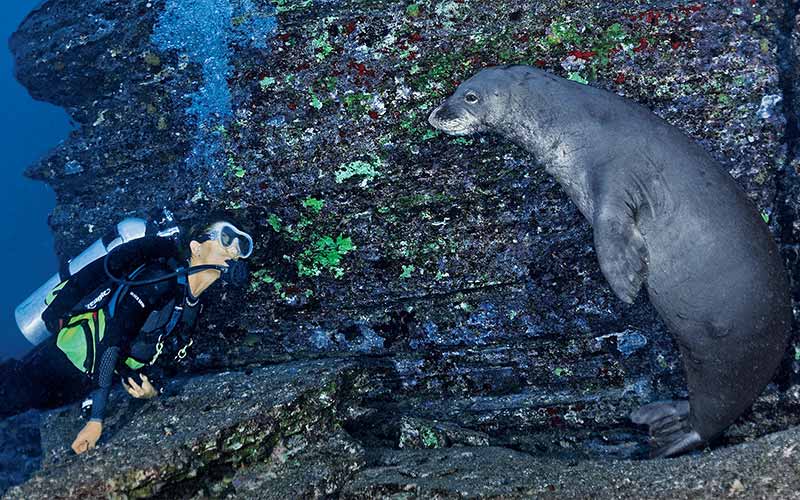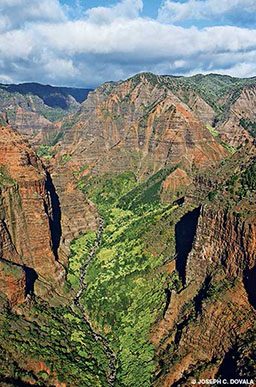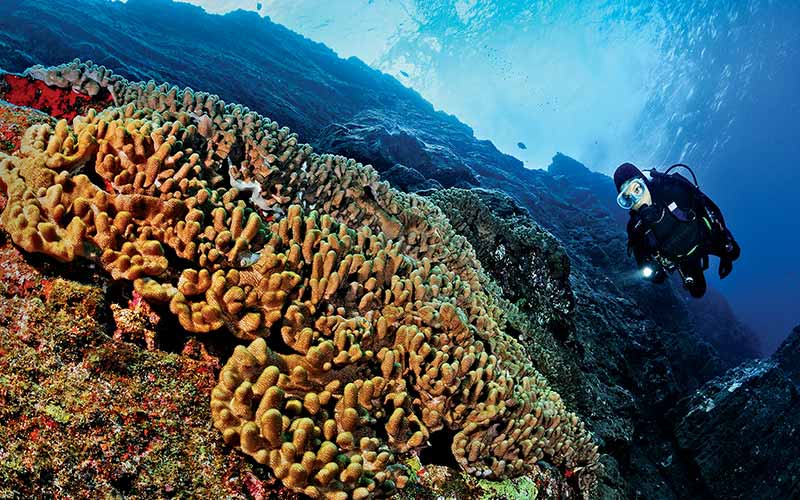The sky darkened heavily to the south — an unusual occurrence. Ikaiki’s double-hulled war canoe, or wa’a kaulua, sliced through the building seas in his final run to Kauai. Ikaili was one of hundreds of veterans hand-picked by King Kamehameha I to forcibly unite the last “outlaw” Hawaiian island into his united kingdom. The armada’s long voyage from Oahu had been uneventful until now.
Ikaiki’s captain became increasingly agitated as he urged the paddlers to dig deeper into the darkening sea. His exhortations were to no avail; in less than an hour the full force of the vicious storm was upon them. Kamehameha’s warriors fought the raging sea with valor, but the fleet was scattered, and the night became a struggle for survival. In the early morning light the fleet was in tatters, with most of the ships sunk and their crews sleeping in the deep blue.
Ikaiki awoke clinging to a spar, weak and dehydrated. He had survived the black night, but just barely. His wa’a kaulua and shipmates were gone — he was alone. After a while he heard a stirring behind him; he spun around expecting a mano (shark), a manifestation of one of his aumakua (spirit guides) coming to escort him to the afterlife. Instead it was curious na mea hulu, “the furry one.” The monk seal looked into Ikaiki’s eyes with a mournful gaze before it dived back beneath the surface. Looking to the west, Ikaiki could just make out the mountains of Kauai, but before long his aumakua appeared to guide him to the next world.

Our dive boat, Kukuula, was cruising over smooth seas on the way to Niihau Island. As happened 200 years earlier, a storm darkened the sky to the south — an uncommon event, according to our skipper. Niihau is an island of about 70 square miles and only about 100 residents; it’s sometimes called the “Forbidden Island.” We weren’t actually landing on the island but rather seeking out dive opportunities near the islet of Lehua. We really wanted to dive with na mea hulus, and the waters of Niihau seemed the best chance for that.

A remnant of the Niihau volcano, Lehua boasts stunning topography. Its area is less than three-quarters of a square mile, and it’s a Hawaii State Seabird Sanctuary. Some of the very best diving is located here at sites such as Vertical Awareness, Puamuu, Pyramid Point and Neon Cave. Because of the distance from Kauai and the potential for strong currents, Niihau is best suited for more advanced divers. You don’t need a wallet full of C-cards, but good buoyancy control and knowing your limitations are prerequisites.
As the skies got darker we prepared for our first dive at Vertical Awareness. Brian, the skipper, guaranteed interaction with a monk seal, which was a pretty bold pledge. The rain started just as we dropped in. Despite the heavy skies the visibility was at least a hundred feet. Immediately we saw sandbar sharks, manta rays and whitetips. I had to laugh as many of the “big ticket” items Hawaiian diving has to offer made their appearance within the first 10 minutes — but we didn’t see any na mea hulus.
I settled into the dive and enjoyed the fabulous underwater topography. As is often the case, my wife, Janine, and I were playing catchup with the group when we noticed a commotion at the limit of our visibility. After a few fin kicks, lo-and-behold there was a real live monk seal. He seemed to be a large male, and he was curious enough to hang around for the rest of our dive. It was pretty thrilling as the Hawaiian monk seal is one of the most endangered marine mammals in the world; about 1,000 remain, according to the National Oceanic and Atmospheric Administration (NOAA). The rest of the day was wet above the surface as well as below. If you can swing it, Lehua Islet is not to be missed.
Kauai, the Garden Isle, offers some pretty good submersions as well. Some require no boat rides at all. Like most of the other Hawaiian Islands, there’s no shortage of beaches and fabulous coastline. While much of the diving is done along the southern and southwestern coasts, sites exist all around Kauai, so there are typically dive opportunities regardless of the weather. Some popular close boat dives are Zak’s Pocket, Turtle Bluffs and Brennecke’s Ledge. You can expect lots of turtles, snapper schools, frogfish and the occasional pelagic shark, ray or dolphin.

If you want to snorkel or dive from the beach on your own schedule, Tunnel’s Reef (for an advanced excursion) or Koloa Landing (for an easier jaunt) might do the trick. Like anywhere, though, you’re better off stopping at a dive facility and getting current local information first hand. Hiring a guide is never a bad idea.
You won’t find high-rise hotels or vast shopping malls on Kauai. Night life isn’t easy to come by either, but if you’re into spectacular scenery, amazing hikes and some of the most ruggedly beautiful coastline in the world, this is the island for you. When we travel, Janine and I have found considerable value in hiring topside hiking guides. They know every nook and cranny of the island and will pick you up and drop you off right at your hotel — a nice option when you’re dog tired from the treks. There’s plenty of adventure to be found in a visit to the Garden Isle, but there are also plenty of white-sand beaches to stroll along and coconut palms to lie under.
How To Dive It

Conditions and skill level: The Hawaiian Islands are considered tropical, but they tend to be slightly cooler than the Caribbean. Average water temperatures range from the mid-70s (°F) in winter to the low 80s (°F) in late summer. Local conditions create exceptions to these estimates, and heat loss should be considered when planning repetitive diving. Many divers find a good 3mm wetsuit sufficient; others are more comfortable with a 5mm or 7mm suit. Many dive sites have fairly predictable currents, which make drift diving popular. Average visibility is usually pretty good (30-60 feet) but can vary by site and rainfall. Visibility at Niihau is often 100 feet or more due to limited rain and little runoff. Air temperatures range from the mid- to high-70s (°F) in winter to the mid- to high-80s (°F) in summer. Overall, the best diving months are from May through September as fewer strong storms appear then and the water is generally calmer.
Surface interval: Whale watching is an option from December through May. Other topside diversions include kayaking, sightseeing, hiking, surfing, tennis, golf and just about any other outdoor activity you can think of.
Getting there and around: Kauai’s international airport, Lihue (LIH), has many direct flights from the West Coast. American, Alaska, Delta, United and US Airways all have nonstop flights from Los Angeles. You can hop over from Oahu by Hawaiian Air. The time difference is three hours behind Pacific time (PT). In addition to taxis, there is a pretty good bus service around the island. You can also rent cars, motorbikes and bicycles quite easily at a number of locations.
© Alert Diver — Q3 Summer 2014